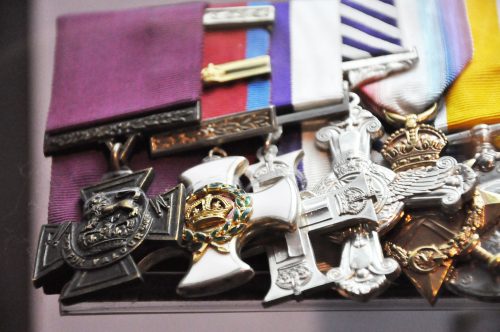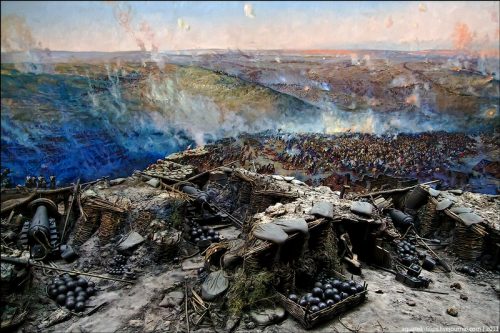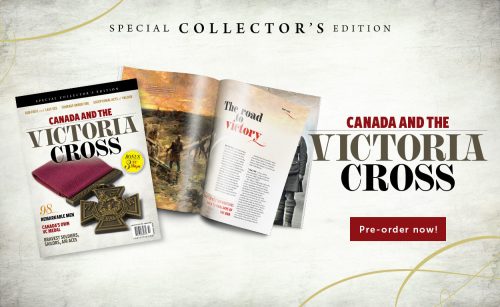
Flying ace Billy Bishop’s medals, including a Victoria Cross (left), are in the Canadian War Museum collection. [CWM]
Everyone knows what a Victoria Cross recipient is made of. But what about the Victoria Cross itself?
Instituted by Queen Victoria at the end of the Crimean War, it has long been believed that the British Empire’s highest award for valour was originally made from bronze taken from Russian cannons captured at Sevastopol in 1855.
Now a British researcher and retired lieutenant-colonel has concluded that it is “highly implausible” the medals, awarded for exceptional gallantry in the presence of the enemy, ever came from Russian guns. Andrew Marriott served 30 years in the Royal Regiment of Fusiliers and is now a visiting researcher at Newcastle University in England.
He said the origin story likely grew out of a highly suspect newspaper report of the day bolstered by a letter to the London Times editor from a Crimean War veteran.
“Although we know that Queen Victoria decreed that the new honour be cast from bronze, there is no evidence to suggest that she wanted captured weapons from Sevastopol to be used for this purpose,” said Marriott, whose research is published in the journal Post-Medieval Archaeology. “Like many at the time, the Queen saw little to celebrate from the victory at Sevastopol, and had displayed little interest in the captured Russian ordnance.
There were notable changes in composition compared with the 19th century versions.
“The only contemporary record of a Sevastopol connection is a newspaper report of the medal ceremony in Hyde Park in 1857. The correspondent most likely conflated various stories circulating about the redistribution and recycling of captured Crimean guns.”
Marriott used X-ray fluorescence scans to examine the composition of 50 VCs awarded between 1856 and 2013, and examined the apparent sources for the medals.
Along with previously unpublished data collected by the Royal Armouries in the 1980s and 1990s, this revealed that partway through the First World War, and again during the Second World War, there were notable changes in composition compared with the 19th century versions. Some are even brass alloys, not bronze.

The Victoria Cross awarded to Edward Holland for his actions in the Boer War in South Africa in 1900. [Wikimedia]
The British decoration was eliminated in Canada when Ottawa began overhauling the Canadian honours system in 1972. Amid debates over its fate, then-prime minister Pierre Trudeau said Canadians should receive only Canadian decorations.
Canada established its own VC two years after Australia did so in 1991, retaining its name in part at the behest of The Royal Canadian Legion. New Zealand followed suit in 1999.
The Canadian version has not been awarded. The Aussies have awarded four VCs since creating their own; the Kiwis one—all coming for actions in Afghanistan.
The current source of metal for the British Victoria Cross is understood to be a cascabel—the round protrusion at the back of a cannon used to secure recoil cables—which is stored under secure conditions at a Ministry of Defence depot in Donnington, England.
Marriott found historical evidence that this cascabel may have been taken from a gun captured during the Second Anglo-Chinese War (also known as the Second Opium War) in 1860, three years after the first VCs were awarded.
“Most of the VCs awarded since World War I have plausibly been sourced from the cascabels of captured guns.”
Use of this, or other cascabels, as the so-called “mother” metal for Victoria Crosses began early in the First World War, when a supply of the metal was given to the London jewellers Hancocks, the sole appointed makers of the award.
A 1942 newspaper report claimed this supply had run out, prompting the Donnington commandant to clarify in 1943 that the depot still held 53 pounds of the metal and sent some to Hancocks. Marriott said this indicates that Victoria Crosses were cast from bronze from an unknown source for at least one year during the Second World War.
About 15 years ago, metallurgist John Ashton analyzed 54 VCs then held by the Australian War Memorial, a shrine and museum in Canberra. He concluded that the metals composition and casting method left no doubt the cannons were Chinese. Ashton made similar findings in New Zealand in 2014.
British Forces War Records acknowledges “recent research has thrown doubt” on the Sevastopol story, noting studies suggest “a variety of origins for the material actually making up the medals themselves.”
It maintains subsequent research “has established that the gunmetal for many of the medals came from Chinese cannons that may have been captured from the Russians in 1855.” It’s unclear how or when the Russians would have acquired them. Russia annexed parts of China during the Second Opium War in 1858, two years after the first VCs were struck.

A detail from the panoramic painting of the Siege of Sevastopol (1854–1855) by Russian artist Franz Roubaud. [Franz Roubaud]
The last Canadian to earn a VC was Lieutenant Robert Hampton Gray, a Corsair pilot whose posthumous award came after he was killed while sinking a Japanese escort ship on Aug. 9, 1945.
The Canadian version, which bears the Latin inscription “Pro Valore” instead of “For Valour,” is cast from bronze donated by Queen Elizabeth II, as well as metal from the 1967 Confederation Medal and from each of Canada’s regions.
“While it’s unlikely that even the earliest medals came from the ordnance captured at Sevastopol,” said Marriott, “it is clear that most of the VCs awarded since World War I have plausibly been sourced from the cascabels of captured guns—an important and symbolic fact for those who have received the honour in recognition of their bravery.”
___
Look for the latest edition of Canada’s Ultimate Story, “Canada and the Victoria Cross,” written by Tom MacGregor, now available for pre-order online in the Legion Magazine shop; and appearing on newsstands Nov. 2.
Advertisement




















